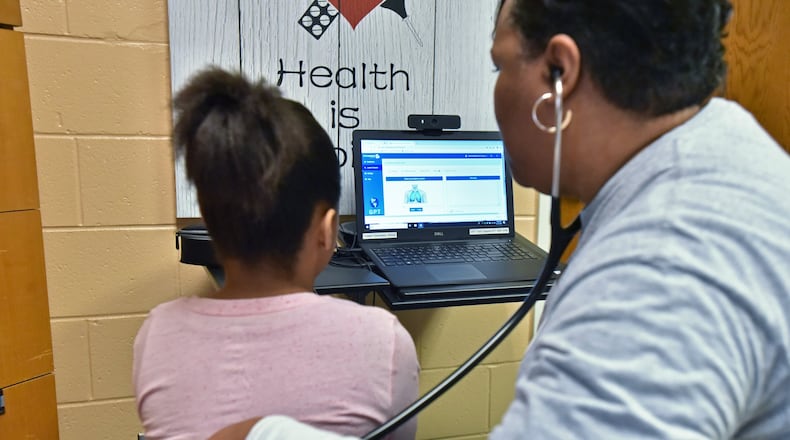Metro Atlanta school districts are adding in-school healthcare access for students, in line with a growing belief that healthier students can result in better learning and performance.
In the last few years, Atlanta Public Schools has opened five school-based health centers, the Fulton school district has opened two, Clayton one and DeKalb launched clinics at four elementaries.
The goal is to make sure students, particularly poor children and those who visit doctors less often, have access to care. It’s part of the growing interest across the state and nation to link health to education.
“If they are not feeling well, they are not going to be attentive in school. They are not going to be able to participate and learn,” said Valencia Hildreth, comprehensive health services manager for APS.
A 40-foot medical van now stops regularly at 11 Atlanta schools, caring for students with asthma. And this month, Atlanta’s Fickett Elementary started using a telehealth program that enables students with a fever, rash or other ailment to go to the school nurse’s office where they can be seen via online video by a nurse practitioner who works for Children’s Healthcare of Atlanta.
Full-service health centers are located in a small fraction of Georgia’s roughly 2,200 schools, but their popularity is surging. For years, Georgia had only a couple of school-based health centers —doctor’s office located in a school or on school property. but since 2013, the number has soared to 40, and more are in the planning stages.
Nationwide, the number of school health centers has more than doubled in the last two decades to an estimated 2,500.
There’s a need for services that fill the gaps the school system is ill-equipped to handle, said Dr. Veda Johnson, an Emory University School of Medicine professor who leads efforts to open school-based health centers in Georgia.
In the 1990s, Johnson helped start a pioneering school-based health center at what was then Whitefoord Elementary School in Atlanta.
“Our goal is clearly to add more,” she said. “Even though we’ve grown quite extensively over the past five years we still have a long way to go.”
She’s advocating for state funding to open more centers in Georgia.
Money for school-based health centers can come from grants and organizations that partner with school districts, such as community health organizations. Like other medical sites, the centers can bill insurance or Medicaid.
School districts chip in by providing the space to house the health center. Sometimes, the district helps with renovation costs, as APS did to transform space at Miles and Dobbs elementary schools. But there’s no ongoing funding in the APS budget to support health centers, officials said.
Many advocates believe that a school-based health center is the best model for reaching disadvantaged and underserved children. Services vary, but the idea is to meet a range of primary health care needs — from diagnosis and treatment of chronic illnesses to screenings and sports physicals. Some also have a dentist and behavioral health provider, who can help with anxiety, depression and other issues.
Who the centers serve also depends on each site, said John Schlitt, president of the Washington, D.C.-based School-Based Health Alliance. Some are geared to students and staff who work at the school, while others may serve a larger community.
The School-Based Health Center at North Clayton High School sees students from 25 schools, treating children for health problems such as diabetes and hypertension and offering nutritional counseling, weight loss help, immunizations, sick visits and other care. Beginning this year, students who attend the other schools can be transported during the school day to the high school health center for a medical appointment. The idea is to reduce the number of days students miss classes because of a minor illness.
Schools also are experimenting with other health-service models, including ones that aren’t as comprehensive. From her office at Fickett Elementary, school nurse Satonya Kimbro can talk via an online video chat with Martha Cargill, a nurse practitioner at Children’s Healthcare of Atlanta.
A student with a fever or sore throat only needs to walk down the hallway to see Kimbro, who with a few taps to a laptop computer connects with Cargill, whose face appears on the screen and whose voice fills the room.
When Kimbro places her stethoscope on a student’s chest, Cargill can hear the heartbeat and breathing. When Kimbro points a camera at the child’s arm, Cargill can see images of that same patch of skin.
“It keeps from going to the hospital for very little things. We can know right here and not have to go all the way downtown, pay for parking and the inconvenience,” said Frances Smith, whose daughter, Sonja, is a Fickett fourth-grader.
CareSource, a nonprofit health insurer, provided the $10,000 worth of equipment to get the program going. Fickett Principal Benita Grant jumped at the chance to help families access health care services. The service also preserves the paychecks of moms and dads who don’t get paid time off to take their child to the doctor.
“It just makes things easier for kids to stay in school and to learn and to do it being well— that’s the biggest thing,” Grant said.
Fickett has about 520 students, and about 150 have turned in parental consent forms giving permission to use the telehealth service.
Officials said, however, that while the program offers a convenient, in-school connection to a medical provider, it is not a replacement for children regularly seeing a primary-care doctor. As such, some experts approach telehealth offerings with caution. Johnson said children need to receive comprehensive care, and she and Schlitt said telehealth should be part of a larger, wider system of health care.
So far, Fickett is the only Atlanta school to offer telehealth. Nicole Spiller, APS director of intervention and support, said the district approached the service strategically by pairing it with the mobile asthma care van, which also serves Fickett students.
She sees “real potential” in the telehealth program.
APS plans to study the results of school health services before making decisions about adding more.
Why it matters
Student performance is linked to health. For instance, a student with undiagnosed poor vision will have trouble learning. Or, a student who is out frequently for minor illnesses will miss lessons. School systems, especially those with high ratios of poor students, are incorporating health services to improve student outcomes.
About the Author
Keep Reading
The Latest
Featured


